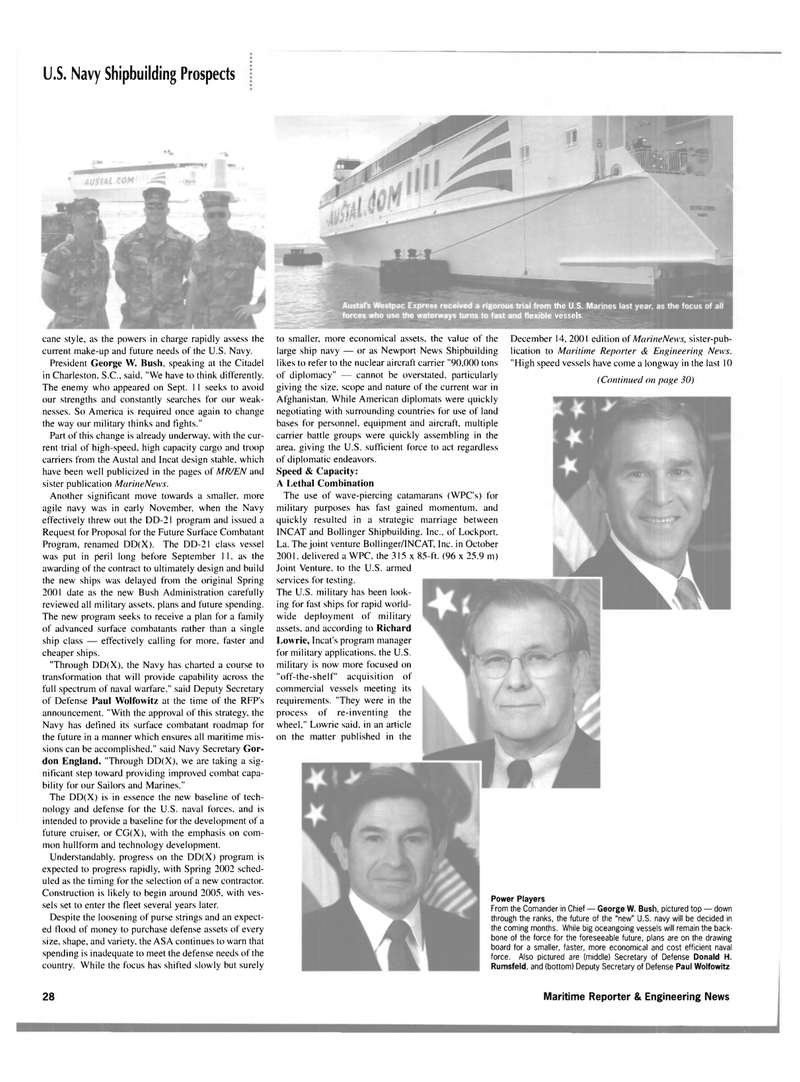
Page 31: of Maritime Reporter Magazine (January 2002)
Read this page in Pdf, Flash or Html5 edition of January 2002 Maritime Reporter Magazine
U.S. Navy Shipbuilding Prospects cane style, as the powers in charge rapidly assess the current make-up and future needs of the U.S. Navy.
President George W. Bush, speaking at the Citadel in Charleston, S.C., said. "We have to think differently.
The enemy who appeared on Sept. 1 1 seeks to avoid our strengths and constantly searches for our weak- nesses. So America is required once again to change the way our military thinks and fights."
Part of this change is already underway, with the cur- rent trial of high-speed, high capacity cargo and troop carriers from the Austal and Incat design stable, which have been well publicized in the pages of MR/EN and sister publication MarineNews.
Another significant move towards a smaller, more agile navy was in early November, when the Navy effectively threw out the DD-21 program and issued a
Request for Proposal for the Future Surface Combatant
Program, renamed DD(X). The DD-21 class vessel was put in peril long before September 11, as the awarding of the contract to ultimately design and build the new ships was delayed from the original Spring 2001 date as the new Bush Administration carefully reviewed all military assets, plans and future spending.
The new program seeks to receive a plan for a family of advanced surface combatants rather than a single ship class — effectively calling for more, faster and cheaper ships. "Through DD(X), the Navy has charted a course to transformation that will provide capability across the full spectrum of naval warfare," said Deputy Secretary of Defense Paul Wolfowitz at the time of the RFP's announcement. "With the approval of this strategy, the
Navy has defined its surface combatant roadmap for the future in a manner which ensures all maritime mis- sions can be accomplished." said Navy Secretary Gor- don England. "Through DD(X), we are taking a sig- nificant step toward providing improved combat capa- bility for our Sailors and Marines."
The DD(X) is in essence the new baseline of tech- nology and defense for the U.S. naval forces, and is intended to provide a baseline for the development of a future cruiser, or CG(X), with the emphasis on com- mon hullform and technology development.
Understandably, progress on the DD(X) program is expected to progress rapidly, with Spring 2002 sched- uled as the timing for the selection of a new contractor.
Construction is likely to begin around 2005, with ves- sels set to enter the fleet several years later.
Despite the loosening of purse strings and an expect- ed flood of money to purchase defense assets of every size, shape, and variety, the ASA continues to warn that spending is inadequate to meet the defense needs of the country. While the focus has shifted slowly but surely 28 Maritime Reporter & Engineering News the U.S. vessels.
Power Players
From the Comander in Chief — George W. Bush, pictured top — down through the ranks, the future of the "new" U.S. navy will be decided in the coming months. While big oceangoing vessels will remain the back- bone of the force for the foreseeable future, plans are on the drawing board for a smaller, faster, more economical and cost efficient naval force. Also pictured are (middle) Secretary of Defense Donald H.
Rumsfeld, and (bottom) Deputy Secretary of Defense Paul Wolfowitz to smaller, more economical assets, the value of the large ship navy — or as Newport News Shipbuilding likes to refer to the nuclear aircraft carrier "90,000 tons of diplomacy" — cannot be overstated, particularly giving the size, scope and nature of the current war in
Afghanistan. While American diplomats were quickly negotiating with surrounding countries for use of land bases for personnel, equipment and aircraft, multiple carrier battle groups were quickly assembling in the area, giving the U.S. sufficient force to act regardless of diplomatic endeavors.
Speed & Capacity:
A Lethal Combination
The use of wave-piercing catamarans (WPC's) for military purposes has fast gained momentum, and quickly resulted in a strategic marriage between
INCAT and Bollinger Shipbuilding, Inc.. of Lockport,
La. The joint venture Bollinger/INC AT. Inc. in October 2001, delivered a WPC. the 315 x 85-ft. (96 x 25.9 m)
Joint Venture, to the U.S. armed services for testing.
The U.S. military has been look- ing for fast ships for rapid world- wide deployment of military assets, and according to Richard
Lowrie, I neat's program manager for military applications, the U.S. military is now more focused on "off-the-shelf" acquisition of commercial vessels meeting its requirements. "They were in the process of re-inventing the wheel." Lowrie said, in an article on the matter published in the
December 14, 2001 edition of MarineNews, sister-pub- lication to Maritime Reporter & Engineering News. "High speed vessels have come a longway in the last 10 (Continued on page 30)

 30
30

 32
32
